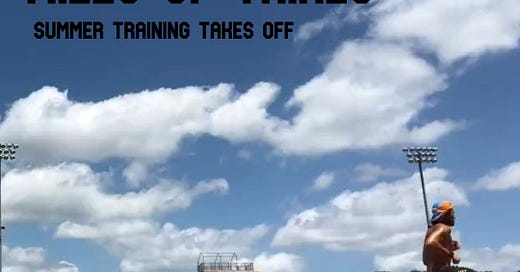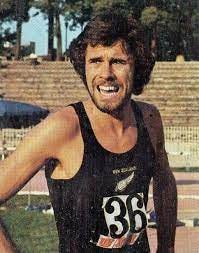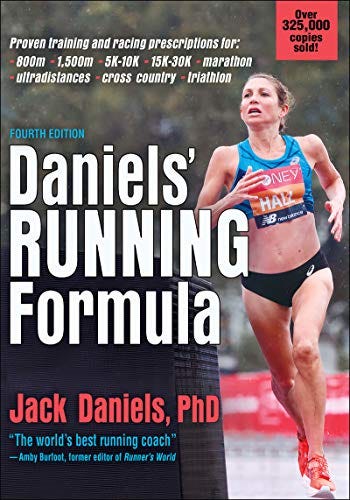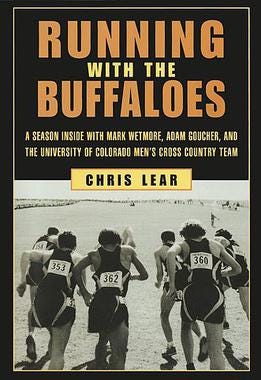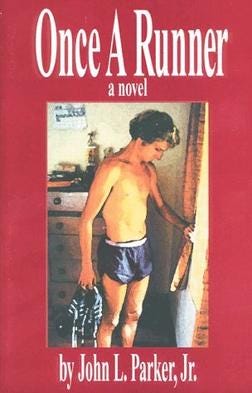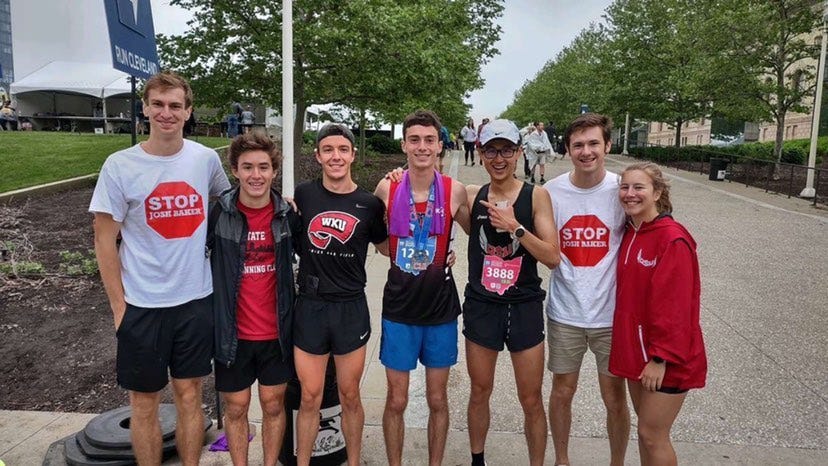Solstice be damned — summertime has arrived. It’s toasty, it’s humid, and (most importantly) school is coming to a close. The college kids, alreleased from their usual academic obligations, are now free to run as many miles as they please. Summer running is a beast in itself, navigating weather, time-mananagement, and the urge to run an obscene amount of miles.
It’s a delicate balance, summer mileage. On one hand, you have to be careful. Listen to your body, don’t overstrain (or, at least, don’t over-overstrain), and limit your volume aspirations to that which you can attain through a steady, incrimental climb.
On the other hand, have you read Once a Runner? Do you, like I, have a DIY poster of Frank Shorter on your bedroom wall1? Have you SEEN Molly Seidel’s Strava? There is a certain attitude that underlies the culture of distance running training — that if you’re not running an ungodly amount of miles, then you’ll never live up to your potential. Now, must of us who’ve been around the block a few times (literally and metaphorically, as it were) know better to indulge this side of ourselves. Still, it’s there, whispering in our ears like a tiny, pitchfork-wieldling Bruce Denton on our shoulders.
For those of us still in step with the collegiate seasons (XC in the Fall, track in the Winter and Spring), Summer is a time for base building. It’s a time for lots of long, easy miles. For tempos, doubles, and strides — lots of strides. My personal Summer training mantra comes from the great Kiwi runner Rod Dixon of the 70s: “All I want to do is drink beer and train like an animal.” Now there’s a program I can get behind!
I myself have only been running for a few years. I’ve never had a coach, and my success has been… let’s call it “incremental.” Obviously, I am not a guy to take training advice from, nor will I try to dish any out. What I have done, however, is a LOT of research about training from a plethora of different sources. What I didn’t know about training I set about trying to learn ASAP, and there was a whole lot I didn’t know. Let’s be honest — there’s still a lot I don’t know, but that, I fear, will always be the case. Such is life. Such is running.
Since I am neither fast nor a coach, this is not a guide to Summer training. It’s a collection of some of the resources that I have found most useful, most interesting, or most inspiring as I buckle down and dive into Summer training. Even if you adopt very little of that which I have assembled here, all of it is worth a read.
Summer of Malmo
Not so much a training plan as a season framework, the Summer of Malmo comes from Olympian and former American Record holder George Malley (often referred to by his nickname, Malmo). The program, in essence, is this:
Run as much mileage as you can (without going overboard!)
Start running doubles as frequently as you can handle without breaking down
Two controlled workouts a week, taking care to stay relaxed and not to overdo it:
A 4-6 mile tempo2
Either a long-interval threshold session with 400m jog rests (i.e. 4x 1600m off a lap jog) OR an easy speed session (think 16x 200m at mile pace, taking as much time as you need between reps)
Do all this with your friends and have a good time.
There are plenty of details to the “Summer of Malmo” framework that I have glossed over. The full article can be found here. The program notably lacks usual base-phase staples like hill work, strides, and an emphasis on the long run. Still, it’s been generally agreed that — if done correctly — the “Summer of Malmo” will definitely make you faster come cross country season.
Collegiate Training Logs
In my frequent and borderline compulsive search for training information, I came across this collection of training from several elite collegiate programs, including Oregon, Stanford, and NAU. While it definitely shouldn’t be attempted workout-for-workout, it can be emulated and adapted for us lower-mileage, less-durable athletes.
Additionally, in my occasional trawlings of that dreaded cesspool known as Letsrun, I came across this Google Drive folder of training logs from several elite collegiate and professional runners. Joe Klecker, Ben True, and Conner Mantz are all there, not to mention a summary of Renato Canova’s Base Phase and a painstakin recreation of the 1998 Colorado XC season, as described in Chris Lear’s classic Running With the Buffalos (more on that later).
Bill Rogers 1975 Training Log
This one’s for the marathoners. This one comes with a hefty DON’T TRY THIS AT HOME. I dug up the training logs of Boston legend Bill Rogers, one of the kings of the 70s mileage monsters. It’s truly mind-boggling to read — this man ran up to 200 miles per week on occasion. It’s also a great reminder of what it takes to be great. Next time you’re feeling sorry for yourself before a 3-mile double, take a look at this. The road to greatness is more often slogged down than sprinted.
Read the full training log here.
Daniels’ Running Formula
Little needs to be said about this book. It is, in many ways, the standard training book for distance running, the tome of all tomes. Jack Daniels’ work in excercise physiology (and, for that matter, coaching) is one of the most important contributions ever to the training world. Even if you don’t choose to buckle down and carefully follow one of his (extremely intense) training plans, the principles of training laid out in this book are invaluable to anyone trying to get faster without a coach.
Out of Thin Air — Michael Crawley
Probably my favorite of the nitty-gritty training-focused running books I’ve read. Wonderfully written, this book is at times gripping, informative, and remarkably funny. Crawley, a Scottish cultural anthropologist and 2:20 marathoner, embeds himself among a group of elite Etheopian runners in Addis Ababa for 15 months. It’s an incredibly enlightening book, not to mention a motivating one.
Running With the Buffalos - Chris Lear
More of an XC book than a Summer book, but a classic nonetheless. Whadya want me to say — it’s a classic!
As motivating as it is, it’s also, I think, a cautionary tale about listening to your body and avoiding overtraining. Without spoiling anything (and without any disrespect to Mark Wetmore OR his ponytail), I encourage you to read this book and take note of how many of the CU runners are persistently injured, sick, or both. Don’t spend your summers battling your own bodies — take a day off every now and again!
Once a Runner - John L Parker Jr
You know I had to. You KNOW I had to. I think Quenton Cassidy might by the runners’ Holden Caufield3. Read into that what you want.
If you’re willing to sit through some melodramatic, even subpar writing (you get used to it as the book goes on!) and take its training advice with a grain of salt, no book will get you up and excited to train quite like Once a Runner. It captures the running experience better than anything I’ve ever read, and — painful as it is to admit — better than anything I’ve ever written. Out of print, incredibly niche, and impossible to find until its recent revival, the book is now widely available in paperback and even in some libraries.
Club Highlights
Nicky Alexander of Cincinnatti has been running out of his mind these past few weekends. After running a 3:55/1:55 1500m/800m double at the Ashland Alumni Open at the end of April, he returned to the track a week later with 3:56/1:54 (1:53.997, before rounding up) performances in the same event. This is all after running 14:48 at the Jesse Owens Invitational 5000m the weekend prior. And did I mention this man’s a Junior? Definitely a name to watch going into his senior year, Nicky Alexander has to be one of the most dangerous all-rounders in the league right now. Somebody get him in a 10,000m!
Elsewhere in Ohio, OSU’s Josh Baker ran 2:38:28 to take second overall at this year’s Cleveland Marathon. That time (just around 6-flat for all 26.2) is nothing to sneeze at, especially considering the winner ran 2:31!
Nick Wolk — who by this point should need no introduction — ran 65:37 at the hilly Pittsburgh half marathon in late April, a performance that won him 7th overall, finishing just 2 seconds behind long-distance legend Abdi Abdirahman.
Author’s Note
Okay, look y’all. I know that two weeks ago I spent like 3 paragraphs talking about how it’d be months before I missed another edition. And then I promptly missed the very next week. So sue me4!
In all seriousness, I graduated from the College of William & Mary last Friday. They gave me the piece of paper, made me sit in the sweltering heat and listen to a 30-minute commencement speech inexplicably about F1 racing (true story), and released me out into the world. It was a hectic couple of weeks, to say the least. It only happens once, however, and it’s now behind me. I’ll have way more time to pour into Reasonably Speedy from now on, and that’s exactly what I intend to do. Lace up and get ready, y’all. It’s gonna be a helluva Summer.
This is not a joke. I am a monumental dweeb.
It’s worth noting that Malley seems to be writing for runners whose “tempo” pace is between 5-6 minutes, roughly. For those of us whose honest, controlled tempo pace is still considerably slower than that (like me), it may be more valuable see this as a time-based recommendation. Call it 20-40 minutes. A 6 mile tempo for someone running 5:30s is a 33-minute workout. For someone running 7:30s, it’s a 45-minute workout at the same intensity. Those, it should be apparent, are very different workouts.
I hate The Catcher In the Rye. I love Once a Runner, though.
Please don’t sue me.

